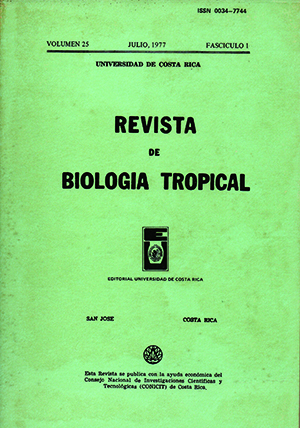Abstract
Nests of the neotropical bees Exomolopsis globosa differ from those of E. similis in the presence of a second entrance, in the angle of the longitudinal axes of the cells and in the type of ground underlying them. In both species two or three females begin to build a nest and most emerging females remain associated with their natal nests. Adult females co-operate in nesting and probably not all of them lay eggs. Developmental mortality was greater in the larger nests of E. globosa than in the smaller ones. It is suggested that several adult females inhabit each nest because this behaviour reduces the risks the bees would encounter if they searched for new nest sites.References
Batra, S. W. T. 1968. Behavior of some social and solitary halictine bees within their nests: a comparative study (Hymenoptera: Halictidae). J. Kans. Entomol. Soc., 41: 120-123.
Dalmau, A. 1970. Catálogo de los himenópteros de Cuba. Instituto Cubano del Libro, La Habana, 218 p.
Danks, H. V. 1971a. Biology of some stem-nesting aculeate Hymenoptera. Trans. R. Entomol. Soc. Lond., 122: 323-399.
Danks, H. V. 1971b. Nest mortality factors in stem-nesting aculeate Hymenoptera. J. Anim. Ecol., 40: 79-82.
Freeman, B. E. 1973. Preliminary studies on the population dynamics of Sceliphron assimile Dahlbom (Hymenoptera: Sphecidae) in Jamaica. J. Anim. Ecol., 42: 173-182.
Freeman, B. E., & D. B. Jayasingh 1975. Factors controlling the distribution in Jamaica of Pachodynerus nasidens (Latr.) (Hymenoptera; Eumenidae). Biol. J. Linn. Soc., 7: 231-241.
Gerber, H. S., & E. C. Klostermeyer 1970. Sex control by bees: a voluntary act of egg fertilization during oviposition. Science, 167: 82-84.
Hicks, C. H. 1936. Nesting habits. of certain western bees. Can. Entomol., 68: 47-52.
Linsley, E. G., J. W. MacSwain, & R. F. Smith 1954. A note on the nesting habits of Exomalopsis solani (Cockerell). Pan-Pacif Entomol., 30: 263-264.
Michener, C. D. 1954. Bees of Panama. Bull. Amer. Mus. Nat. Hist., 104: 1-175.
Michener, C. D. 1964. Reproductive efficiency in relation to colony size in hymenopterous societies. Insectes sociaux, 11: 317-342.
Michener, C. D. 1966. Evidence of co-operative provisioning of cells in Exomalopsis. J. Kans. Entomol., Soc., 39 : 315-317.
Michener, C. D. 1974. The sol:ial behaviour of the bees. Havard Univ. Press, Cambridge, Mass. 408 p.
Mitchell, T. B. 1962. Bees of the eastern United States. Tech. Bull. N. C. Agric. Sta. (152),1-557.
Raw, A. 1972. The biology of the solitary bee Osmia rufa (L) (Megachilidae). Trans. R.Entomol. Soc. Lond., 124: 213-229.
Raw, A. 1976. Seasonal changes in the numbers and foraging activities of two Jamaican Exomalopsis species (Hymenoptera, Anthophoridae). Biotropica, 8: 270-277.
Richards, O. W. 1949. The significance of the number of wing-hooks in bees and wasps. Proc. R Entomol. Soc. Lond., (A), 124: 75-78.
Rozen, J. G., & c. D MacNeill 1957. Biological observations on Exomalopsis (Anthophorula) chionura Cockerell, including a comparison of the biology of Exomalopsis with that of other anthophorid groups (Hymenoptera: Apoidea). Ann. Entomol. Soc. Amer., 50: 522-529.
Southwood, T. R. E. 1966. Ecological methods. Methuen, London. 391 p.
Spradbery, J. P. 1973. Wasps. Sidgwick and J ackson, London. 408 p.
Wolcott, G.N. 1948. The insects of Puerto Rico (Hymenoptera). J. P. Rico Insul. Agric. Exp. Sta., 32: 749-873.
Comments

This work is licensed under a Creative Commons Attribution 4.0 International License.
Copyright (c) 1977 Revista de Biología Tropical


